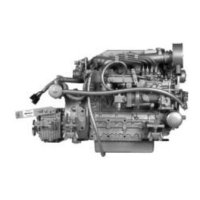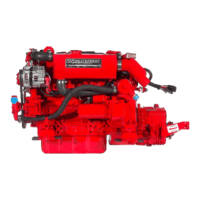LAY-UP
&
RECOMMISSIONING
Many
owners
rely
on their boatyards to prepare their craft,
including engines and generators,
for
lay-up during the
off-
season or
for
long periods of inactivity. Others prefer
to
accomplish lay-up preparation themselves.
The
procedures which follow will allow
you
to
perform your
own
lay-up
and
recommissioning, or
you
may
use
them
as
a
check list if others do the procedures.
These procedures should afford your engine protection
during a lay-up
and
also help familiarize
you
with
the
maintenance needs of your engine.
If
you
have
any
questions regarding lay-up procedures, call
your
local servicing dealer; he will
be
more
than
willing
to
provide assistance.
Propeller
Shaft
Coupling
[Propulsion
Engine]
The
transmission and propeller half couplings should always
be
opened
up
and
the bolts removed
when
the
boat
is
hauled
out
of
the water or moved from land to
water,
and
during
storage
in the cradle. The flexibility of
the
boat often puts a
severe strain
on
the
propeller shaft or coupling or both, while
the boat is
taken
out or put in the
water.
In some cases,
the
shaft
has
actually been bent by these strains. This does not
apply
to small boats that are hauled out of
the
water
when
not
in
use, unless
they
have been dry for a considerable
period of
time.
Fresh
Water
Cooling
Circuit
A 50-50 solution of antifreeze and distilled water
is
recommended for use
in
the coolant system at all times.
This
solution
may
require a higher concentration of
antifreeze, depending
on
the area's winter climate. Check
the
solution to make sure the antifreeze protection
is
adequate.
Should
more antifreeze
be
needed,
drain
an
appropriate
amount
from
the engine block and
add
a
more
concentrated
mixture.
Operate
the engine
to
ensure a complete circulation
and
mixture of
the
antifreeze concentration throughout
the
cooling
system.
Now
recheck
the
antifreeze solution's strength.
Lubrication
System
With
the engine warm, drain
all
the
engine
oil
from
the
oil
sump.
Remove
and
replace the
oil
tilter
and
till
the
sump
with
new
oil.
Use
the correct grade of
oil.
Refer
to
the
ENGINE
LUBRICATING
OIL pages
in
this manual
for
the
oil
changing procedure. Run the engine
and
check
for
proper
oil
pressure
and
make sure there are
no
leaks.
A
CAUTION:
011
nllt
leave
the
engine's
old
engine
III/In
the
SII1IIP
llvel
the
lay-up
period.
Engine
oil
and
tIIIIIIbusIlon
deposits
combine
til
produce
hannful
chemicals
which
can
reduce
the
life
of
YOUI
engine's
internal
paris.
Fuel
System
[Gasoline]
Top
off your
fuel
tanks
with unleaded gasoline of
89
octane
of
higher.
A
fuel
conditioner such
as
STABIL
gasoline
stabilizer should be added. Change the element
in
your
gasoline/water separator and clean the metal bowl.
Re-install
and
make certain there are no leaks. Clean
up
any
spilled
fuel.
Fuel
System
[Diesel]
Top
off your
fuel
tanks with No.2 diesel
fuel.
Fuel
additives
such
as
BIOBOR
and
STABIL
should be added at
this
time
to
control algae
and
condition the
fuel.
Care should
be
taken
that the additives used are compatible with
the
primary
fuel
tilter/water separator
used
in
the
system. Change
the
element
in
your primary
fuel
tilter/water separator, if the
fuel
system
has
one,
and
clean the separator sediment bowl.
Change the
fuel
tilter elements
on
the
engine
and
bleed
the
fuel
system,
as
needed. Start the engine and allow
it
to
run
for
5 -
10
minutes
to
make sure
no
air
is
left
in
the
fuel
system. Check for
any
leaks that
may
have been created
in
the
fuel
system during
this
servicing, correcting
them
as
needed.
Operating
the
engine
for
5 -
10
minutes
will
help
allow movement of
the
treated
fuel
through the injection
equipment
on
the engine.
Raw
Water
Cooling
Circuit
Close the through-hull seacock. Remove
the
raw
water
intake
hose
from
the
seacock. Place
the
end of this hose
into
a tive
gallon bucket of clean fresh
water.
Before starting the engine,
check
the
zinc
anode
found
in
the
primary heat exchanger
on
the
engine
and
clean or replace it
as
required,
and
also
clean
any
zinc debris
from
inside the heat exchanger where
the
zinc
anode
is
located. Clean the
raw
water strainer.
Start
the
engine
and
allow
the
raw water pump
to
draw
the
fresh water through
the
system. When the bucket
is
empty,
stop
the
engine
and
retill
the
bucket with
an
antifreeze
solution slightly stronger
than
needed for winter
freeze
protection
in
your
area.
Start the engine
and
allow
all
of this mixture to
be
drawn
through the
raw
water system. Once the bucket
is
empty,
stop
the
engine. This antifreeze mixture should protect
the
raw
water circuit
from
freezing during
the
winter lay-up,
as
well
as
providing corrosion protection.
Remove
the
impeller
from
your
raw
water pump
(some
antifreeze mixture
will
accompany it, so catch
it
in
a bucket).
Examine
the
impeller.
Acquire a replacement, if
needed,
and
a cover gasket. Do not replace
the
impeller (into
the
pump)
until recommissioning, but replace
the
cover
and
gasket.
Cylinder
Lubrication
[Gasoline]
With the engine running, remove
the
flame
arrester
and
spray
fogging
oil
into
the open air intake. The fogging
oil
will
stall
out
the
engine
as
it
coats
the
valves, cylinders
and
spark
plugs
for
winter protection.
~
WESTl:RBEKE
Engines & Generators
56
